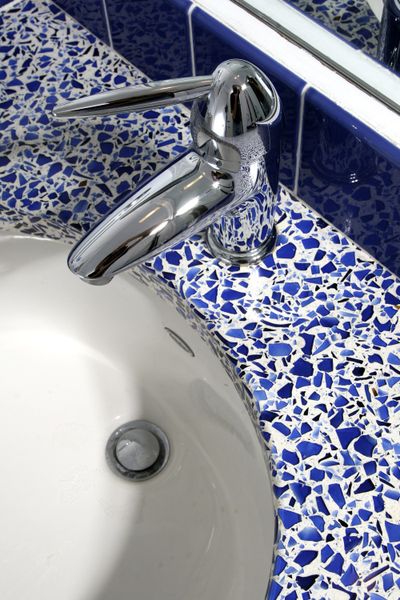High tech goes green
Advances mean designers can be stylish and environmentally friendly

NEW YORK – A decade of quantum technological leaps mean today’s designers have in their hands a virtually bottomless toy box of new materials and methods.
Take the award-winning installation “Lightshowers” put on by DuPont Corian at this year’s International Contemporary Furniture Fair. Egg-like polished rocks and smooth slabs of Corian were underlit, with nature sounds generated from a hypersonic speaker; when a person crossed the sound wave’s path, it essentially “woke” the sound.
Or look at Vetrazzo, a Richmond, Calif., countertop maker that turns a good portion of the state’s recyclables – old traffic lights, curbside trash, windows, even dishware factory rejects – into chic countertops.
The technology boom echoes an earlier era: The icons of early 20th century Modernism – Breuer, Le Corbusier, van der Rohe, Gray, the Eames, and others – eagerly adapted machine-age materials like tubular steel and molded plywood into furniture that was new, daring and still accessible.
Now advances are not just industrial – they’re green. Eco-friendly paints and adhesives, water-driven machinery, precision lasers, even organic powder coatings for steel are all relatively new technologies borne of the industry’s desire to balance style and stewardship.
With computers, designs are generated, presented and communicated digitally for what the industry calls “rapid prototyping and manufacturing.” What it means is that software helps the designer draw, say, a chair, then it creates a 3D prototype in a few hours, which can then be produced with minimal waste in a variety of customizations, a process that used to take months.
Emmanuel Plat, president of ConranUSA, is excited about the technology used by a Swedish design firm called Front.
“An artist uses a special pen to sketch her design in the air – she can’t even see what she’s drawing,” he said. “A motion-capture camera records her strokes, then the image is prototyped – the process is really remarkable.”
But does the “wow factor” translate into useful furniture? Max Shangle, chair of the furniture design program at Kendall College of Art and Design in Grand Rapids, Mich., says products made with revolutionary technology must still resonate with the consumer.
“The question isn’t, ’Can we make it?’ but ’Should we make it?’ At the end of the day, we have to produce things that appeal to and satisfy the consumer,” he said. “Using a radical new material isn’t enough.”
In his book, “The Design of Everyday Things,” Donald Norman chides those who put artistry or gadgetry before good design. “Well designed objects are easy to understand,” he writes.
For that, consider the LED lights that now may line the perimeter of a sofa, a room, even a swimming pool.
On the creative horizon, Don Goeman, executive vice president of Research, Design and Development at Herman Miller, sees organic LEDs, as well as programmable lighting scenes, “and smart surfaces that are changeable and customizable.”
Says Shangle, “The potential to change the landscape of product offerings in the home furnishings marketplace is limitless.”
That makes the new generation of modern home furnishings just as exciting as the first.